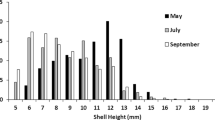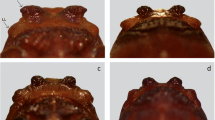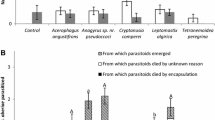Abstract
The cereal leaf beetle,Oulema melanopus (L.), of minor economic importance in Europe, was found in Michigan, USA, in 1959, and has caused increasing damage to small grains. Studies in Europe prompted the introduction into the United States, of 3 hymenopterous parasites of the larval stage:Tetrastichus julis (Walker),Diaparsis carinifer (Thomson), andLemophagus curtus Townes, as a multiplespecies biological control attempt.
From 1964 to 1970, field collections in 10 European countries showed that parasitism averaged 12.3% byD. carinifer, 10.4% byT. julis, and 5.6% byL. curtus. Parasites are discussed with respect to life-history, distribution, constancy, hostrange, synchrony with host, and effects of encapsulation by the host larva. Techniques are described for parasite collection, rearing, shipment, overwintering in quarantine, field release, and recovery.
Adult parasite releases in the USA (1964–1971) totaled 43,054D. carinifer, 31,123T. julis, and 3,109L. curtus. BothD. carinifer andT. julis are known to be established at several sites in Michigan, andT. julis is also established in Ohio.Lemophagus curtus was recovered in Michigan in 1972.
Résumé
Oulema melanopus, Chrysomélide d'importance économique mineure en Europe, fut découvert aux États-Unis en 1959 dans l'État de Michigan et cause aux céréales des dégâts allant croissant.
Des études entreprises en Europe ont activé l'introduction aux États-Unis de 3 hyménoptères parasites du stade larvaire,Tetrastichus julis (Walker),Diaparsis carinifer (Thomson), etLemophagus curtus Townes, dans le but d'un contrôle biologique par plusieurs espèces.
De 1964 à 1970, des prélèvements dans les champs de 10 pays européens ont montré que le parasitisme moyen atteignait 12,3% parD. carinifer, 10,4% parT. julis, et 5,6% parL. curtus. Des études ont été faites sur la biologie de ces parasites, leur distribution, leur régularité, leur synchronisation par rapport à l'hôte, et les effets de leur encapsulation. Des techniques sont décrites pour l'élevage des parasites, leur expédition, leur hivernage en quarantaine, leur libération dans les champs et leur recouvrement.
Les libérations de parasites adultes aux États-Unis (1964–1971) ont totalisé 43.054D. carinifer, 31.123T. julis, et 3.109L. curtus. Il est établi queD. carinifer etT. julis sont implantés en différents points dans l'État de Michigan, etT. julis également dans l'Ohio. En 1972,L. curtus a été retrouvé dans l'État de Michigan.
Similar content being viewed by others
References
Angalet G. W. — 1965. Natural enemies of the cereal leaf beetle,Oulema melanopa (Linnaeus) and the related speciesOulema lichenis (Linnaeus). —Special Report PI-7, USDA, ENT, II&PI Branch, May 1965, 17 pp., unpubl.
Anonymous. — 1969. Distribution maps of pests. Ser. A, Map 260,Oulema melanopus (L.). —Commonw. Inst. Ent., London.
Bartlett, B. R. &Van den Bosch, R. — 1964. Foreign exploration for beneficial organisms. InP. DeBach (ed.), Biological control of insect pests and weeds. —Reinhold, New York, pp. 283–305.
Bjegović, P. — 1967.Meigenia mutabilis Fall. [Dipt. Tachinidae] as a parasite ofOulema melanopa L. and its relation toLeptinotarsa decemlineata Say —Zašt. Bilja,18, 93–100 (in serbian).
Bouček, Z. &Askew, R. R. — 1968. Index of palearcticEulophidae (excl.Tetrastichinae). Index of Entomophagous Insects. —Le François, Paris, 254 pp.
Castro, T. R., Ruppel, R. F. &Gomulinski, M. S. — 1965. Natural history of the cereal leaf beetle in Michigan. —Q. Bull. Mich. agric. Exp. Sta.,47, 623–653.
Clausen, C. P. — 1936. Insect parasitism and biological control. —Ann. ent. Soc. Am.,29, 201–223.
Clausen, C. P. — 1956. Biological control of insect pests in the continental United States. —Tech. Bull. USDA,1139, 151 pp.
Connin, R. B., Cobb, D. L., Gomulinski, M. S. &Arnsman, J. C. — 1966. Plaster of Paris as an aid in rearing insects pupating in the soil. —J. econ. Ent.,59, 1530.
DeBach, P. (ed) — 1964. Biological control of insect pests and weeds. —Reinhold, New York, 844 pp.
Domenichini, G. — 1966. Index of palearcticTetrastichinae. Index of Entomophagous Insects. —Le François, Paris, 101 pp.
Doutt, R. L. &DeBach, P. — 1964. Some biological control concepts and questions. InP. DeBach (ed.), Biological control of insect pests and weeds. —Reinhold, New York, pp. 118–142.
Dysart, R. J. — 1971. Distribution ofAnaphes flavipes in Europe and sources of its importation into the United States. —Entomophaga,16, 445–452.
Flanders, S. E. — 1969.Herbert D. Smith's observations on citrus blackfly parasites in India and Mexico and the correlated circumstances. —Can. Ent.,101, 467–480.
Gruber, F., Rivet, E. &Prieto, C. — 1972. A technique for obtaining cells of a soil-pupating insect,Oulema melanopus. —J. econ. Ent.,65, 904–906.
Hilterhaus, V. — 1965. Biologisch-ökologische Untersuchungen an Blattkäfern der GattungenLema undGastroidea [Chrysomelidae, Col.]. —Z. angew. Zool.,52, 257–295.
Hodson, W. E. H. — 1929. The bionomics ofLema melanopa L. [Criocerinae], in Great Britain. —Bull. ent. Res.,20, 5–14.
Horstmann, K. — 1971. Revision der europäischen Tersilochinen I [Hymenoptera, Ichneumonidae]. —Veröff. Zool. Staatssamml. (München),15, 47–138.
Huffaker, C. B., Messenger, P. S. &DeBach, P. — 1971. The natural enemy component in natural control and the theory of biological control. InC. B. Huffaker (ed.), Biological control. —Plenum Press, New York, pp. 16–67.
Knechtel, W. K. &Manolache, C. I. — 1936. Observatiuni biologice aspura gandacului ovazuluiLema melanopus L. in Romania. —Anal. Inst. Cerc. agron. Roman. (Bucarest),7, 186–208.
Labeyrie, V. — 1963. Sous-famille desCriocerinae, InA. C. Balachowsky (ed.), Entomologie appliquée à l'agriculture, Tome 1, Coléoptères. —Masson et Cie, Paris, pp. 571–592.
Maltby, H. L., Burger, T. L., Moorehead, G. E. &Montgomery, V. E. — 1969. A new record of aTrichogramma species parasitizing the cereal leaf beetle. —J. econ. Ent.,62, 1157–1158.
Maltby, H. L., Stehr, F. W., Anderson, R. C., Moorehead, G. E., Barton, L. C. &Paschke, J. D. — 1971. Establishment in the United States ofAnaphes flavipes, as egg parasite of the cereal leaf beetle. —J. econ. Ent.,64, 693–697.
Mayr, E. — 1966. Animal species and evolution. —Belknap Press, Cambridge, Mass. 797 pp.
Mesnil, L. — 1930. Contribution a l'étude de trois coléoptères nuisibles aux céréales. —Annls. Epiphyt. 16, 190–208.
Parker, H. L., Berry, P. A. & Silveria [sic,Silveira Guido], A. — 1950. Vegetable weevils and their natural enemies in Argentina and Uruguay. —Tech. Bull. USDA,1016, 28 pp.
Pemberton, C. E. &Willard, H. F. — 1918. A contribution to the biology of fruit fly parasites in Hawaii. —J. agric. Res.,15, 419–465.
Sajo, K. — 1893. Das Getreidehähnchen (Lema melanopa L.). —Z. Pflanzenkrh.,3, 127–137.
Salt, G. — 1963. The defence reactions of insects to metazoan parasites. —Parasitology,53, 527–642.
Schlinger, E. I. &Doutt, R. L. — 1964. Systematics in relation to biological control. InP. DeBach (ed.), Biological control of insect pests and weeds. —Reinhold, New York, pp. 247–280.
Simmonds, F. J. — 1963. Genetics and biological control. —Can. Ent.,95, 561–567.
Smith, H. D., Maltby, H. L. & Jimenez-Jimenez, E. — 1964. Biological control of the citrus blackfly in Mexico. —Tech. Bull. USDA,1311, 30 pp.
Stehr, F. W. — 1970. Establishment in the United States ofTetrastichus julis, a larval parasite of the cereal leaf beetle. —J. econ. Ent.,63, 1968–1969.
Stehr, F. W. &Haynes, D. L. — 1972. Establishment in the United States ofDiaparsis carinifer (Thomson), a larval parasite of the cereal leaf beetle. —J. econ. Ent.,65, 405–407.
Townes, H. — 1965. Nomenclatural notes on EuropeanIchneumonidae [Hymenoptera]. —Polskie Pismo ent.,35, 409–417.
Townes, H. — 1969. The genera ofIchneumonidae, part 3. —Mem. Am. ent. Inst.,13, p. 289.
Turnbull, A. L. — 1967. Population dynamics of exotic insects. —Bull. ent. Soc. Am.,13, 333–337.
Turnbull, A. L. &Chant, D. A. — 1961. The practice and theory of biological control of insects in Canada. —Can. J. Zool.,39, 697–753.
Van den Bosch, R. — 1953. Competition among parasites of the Oriental fruit fly. —Proc. Hawaii. ent. Soc.,15, 201–206.
Venturi, F. — 1942. LaLema melanopa L. [Coleoptera, Chrysomelidae]. —Redia,28, 11–88.
Watt, K. E. F. — 1965. Community stability and the strategy of biological control. —Can. Ent.,97, 887–895.
Wellso, S. G. &Hoxie, R. P. — 1969.Hyalomyodes triangulifer parasitizing the cereal leaf beetle,Oulema melanopus. —Ann. ent. Soc. Am.,62, 923–924.
Author information
Authors and Affiliations
Rights and permissions
About this article
Cite this article
Dysart, R.J., Maltby, H.L. & Brunson, M.H. Larval parasites ofOulema melanopus in Europe and their colonization in the United States. Entomophaga 18, 133–167 (1973). https://doi.org/10.1007/BF02372026
Issue Date:
DOI: https://doi.org/10.1007/BF02372026




